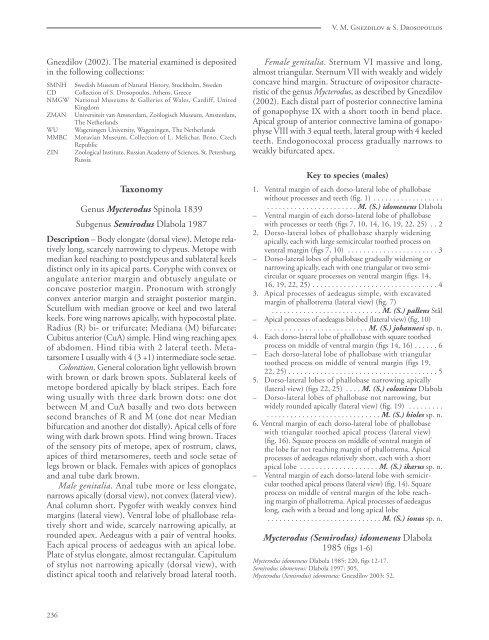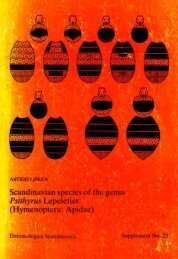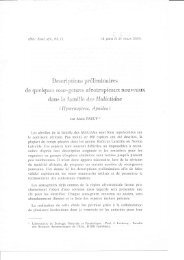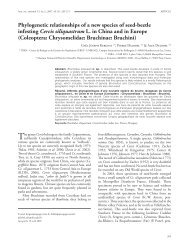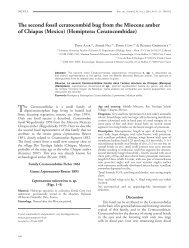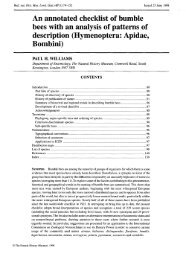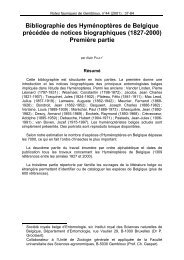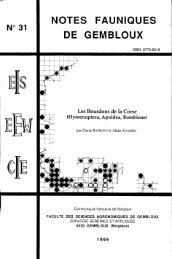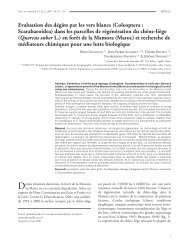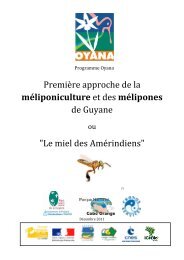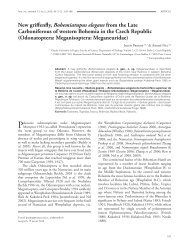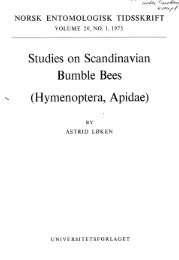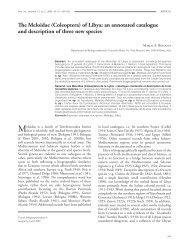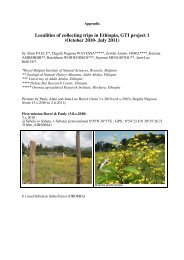Review of the subgenus Semirodus Dlabola of the genus Mycterodus
Review of the subgenus Semirodus Dlabola of the genus Mycterodus
Review of the subgenus Semirodus Dlabola of the genus Mycterodus
Create successful ePaper yourself
Turn your PDF publications into a flip-book with our unique Google optimized e-Paper software.
V. M. Gnezdilov & S. Drosopoulos<br />
Gnezdilov (2002). The material examined is deposited<br />
in <strong>the</strong> following collections:<br />
SMNH<br />
CD<br />
NMGW<br />
ZMAN<br />
WU<br />
MMBC<br />
ZIN<br />
Swedish Museum <strong>of</strong> Natural History, Stockholm, Sweden<br />
Collection <strong>of</strong> S. Drosopoulos, A<strong>the</strong>ns, Greece<br />
National Museums & Galleries <strong>of</strong> Wales, Cardiff, United<br />
Kingdom<br />
Universiteit van Amsterdam, Zoölogisch Museum, Amsterdam,<br />
The Ne<strong>the</strong>rlands<br />
Wageningen University, Wageningen, The Ne<strong>the</strong>rlands<br />
Moravian Museum, Collection <strong>of</strong> L. Melichar, Brno, Czech<br />
Republic<br />
Zoological Institute, Russian Academy <strong>of</strong> Sciences, St. Petersburg,<br />
Russia<br />
Taxonomy<br />
Genus <strong>Mycterodus</strong> Spinola 1839<br />
Sub<strong>genus</strong> <strong>Semirodus</strong> <strong>Dlabola</strong> 1987<br />
Description – Body elongate (dorsal view). Metope relatively<br />
long, scarcely narrowing to clypeus. Metope with<br />
median keel reaching to postclypeus and sublateral keels<br />
distinct only in its apical parts. Coryphe with convex or<br />
angulate anterior margin and obtusely angulate or<br />
concave posterior margin. Pronotum with strongly<br />
convex anterior margin and straight posterior margin.<br />
Scutellum with median groove or keel and two lateral<br />
keels. Fore wing narrows apically, with hypocostal plate.<br />
Radius (R) bi- or trifurcate; Mediana (M) bifurcate;<br />
Cubitus anterior (CuA) simple. Hind wing reaching apex<br />
<strong>of</strong> abdomen. Hind tibia with 2 lateral teeth. Metatarsomere<br />
I usually with 4 (3 +1) intermediate socle setae.<br />
Coloration. General coloration light yellowish brown<br />
with brown or dark brown spots. Sublateral keels <strong>of</strong><br />
metope bordered apically by black stripes. Each fore<br />
wing usually with three dark brown dots: one dot<br />
between M and CuA basally and two dots between<br />
second branches <strong>of</strong> R and M (one dot near Median<br />
bifurcation and ano<strong>the</strong>r dot distally). Apical cells <strong>of</strong> fore<br />
wing with dark brown spots. Hind wing brown. Traces<br />
<strong>of</strong> <strong>the</strong> sensory pits <strong>of</strong> metope, apex <strong>of</strong> rostrum, claws,<br />
apices <strong>of</strong> third metarsomeres, teeth and socle setae <strong>of</strong><br />
legs brown or black. Females with apices <strong>of</strong> gonoplacs<br />
and anal tube dark brown.<br />
Male genitalia. Anal tube more or less elongate,<br />
narrows apically (dorsal view), not convex (lateral view).<br />
Anal column short. Pyg<strong>of</strong>er with weakly convex hind<br />
margins (lateral view). Ventral lobe <strong>of</strong> phallobase relatively<br />
short and wide, scarcely narrowing apically, at<br />
rounded apex. Aedeagus with a pair <strong>of</strong> ventral hooks.<br />
Each apical process <strong>of</strong> aedeagus with an apical lobe.<br />
Plate <strong>of</strong> stylus elongate, almost rectangular. Capitulum<br />
<strong>of</strong> stylus not narrowing apically (dorsal view), with<br />
distinct apical tooth and relatively broad lateral tooth.<br />
Female genitalia. Sternum VI massive and long,<br />
almost triangular. Sternum VII with weakly and widely<br />
concave hind margin. Structure <strong>of</strong> ovipositor characteristic<br />
<strong>of</strong> <strong>the</strong> <strong>genus</strong> <strong>Mycterodus</strong>, as described by Gnezdilov<br />
(2002). Each distal part <strong>of</strong> posterior connective lamina<br />
<strong>of</strong> gonapophyse IX with a short tooth in bend place.<br />
Apical group <strong>of</strong> anterior connective lamina <strong>of</strong> gonapophyse<br />
VIII with 3 equal teeth, lateral group with 4 keeled<br />
teeth. Endogonocoxal process gradually narrows to<br />
weakly bifurcated apex.<br />
Key to species (males)<br />
1. Ventral margin <strong>of</strong> each dorso-lateral lobe <strong>of</strong> phallobase<br />
without processes and teeth (fig. 1) . . . . . . . . . . . . . . . . . .<br />
. . . . . . . . . . . . . . . . . . . . . . . M. (S.) idomeneus <strong>Dlabola</strong><br />
– Ventral margin <strong>of</strong> each dorso-lateral lobe <strong>of</strong> phallobase<br />
with processes or teeth (figs 7, 10, 14, 16, 19, 22, 25) . . 2<br />
2. Dorso-lateral lobes <strong>of</strong> phallobase sharply widening<br />
apically, each with large semicircular too<strong>the</strong>d process on<br />
ventral margin (figs 7, 10) . . . . . . . . . . . . . . . . . . . . . . . 3<br />
– Dorso-lateral lobes <strong>of</strong> phallobase gradually widening or<br />
narrowing apically, each with one triangular or two semicircular<br />
or square processes on ventral margin (figs. 14,<br />
16, 19, 22, 25) . . . . . . . . . . . . . . . . . . . . . . . . . . . . . . . . 4<br />
3. Apical processes <strong>of</strong> aedeagus simple, with excavated<br />
margin <strong>of</strong> phallotrema (lateral view) (fig. 7)<br />
. . . . . . . . . . . . . . . . . . . . . . . . . . . . M. (S.) pallens Stål<br />
– Apical processes <strong>of</strong> aedeagus bilobed (lateral view) (fig. 10)<br />
. . . . . . . . . . . . . . . . . . . . . . . . . M. (S.) johannesi sp. n.<br />
4. Each dorso-lateral lobe <strong>of</strong> phallobase with square too<strong>the</strong>d<br />
process on middle <strong>of</strong> ventral margin (figs 14, 16) . . . . . . 6<br />
– Each dorso-lateral lobe <strong>of</strong> phallobase with triangular<br />
too<strong>the</strong>d process on middle <strong>of</strong> ventral margin (figs 19,<br />
22, 25) . . . . . . . . . . . . . . . . . . . . . . . . . . . . . . . . . . . . . . 5<br />
5. Dorso-lateral lobes <strong>of</strong> phallobase narrowing apically<br />
(lateral view) (figs 22, 25) . . . . M. (S.) colossicus <strong>Dlabola</strong><br />
– Dorso-lateral lobes <strong>of</strong> phallobase not narrowing, but<br />
widely rounded apically (lateral view) (fig. 19) . . . . . . . . .<br />
. . . . . . . . . . . . . . . . . . . . . . . . . . . . . M. (S.) hioles sp. n.<br />
6. Ventral margin <strong>of</strong> each dorso-lateral lobe <strong>of</strong> phallobase<br />
with triangular too<strong>the</strong>d apical process (lateral view)<br />
(fig. 16). Square process on middle <strong>of</strong> ventral margin <strong>of</strong><br />
<strong>the</strong> lobe far not reaching margin <strong>of</strong> phallotrema. Apical<br />
processes <strong>of</strong> aedeagus relatively short, each with a short<br />
apical lobe . . . . . . . . . . . . . . . . . . . . M. (S.) ikarus sp. n.<br />
– Ventral margin <strong>of</strong> each dorso-lateral lobe with semicircular<br />
too<strong>the</strong>d apical process (lateral view) (fig. 14). Square<br />
process on middle <strong>of</strong> ventral margin <strong>of</strong> <strong>the</strong> lobe reaching<br />
margin <strong>of</strong> phallotrema. Apical processes <strong>of</strong> aedeagus<br />
long, each with a broad and long apical lobe<br />
. . . . . . . . . . . . . . . . . . . . . . . . . . . . . M. (S.) ionus sp. n.<br />
<strong>Mycterodus</strong> (<strong>Semirodus</strong>) idomeneus <strong>Dlabola</strong><br />
1985 (figs 1-6)<br />
<strong>Mycterodus</strong> idomeneus <strong>Dlabola</strong> 1985: 220, figs 12-17.<br />
<strong>Semirodus</strong> idomeneus: <strong>Dlabola</strong> 1997: 305.<br />
<strong>Mycterodus</strong> (<strong>Semirodus</strong>) idomeneus: Gnezdilov 2003: 52.<br />
236


